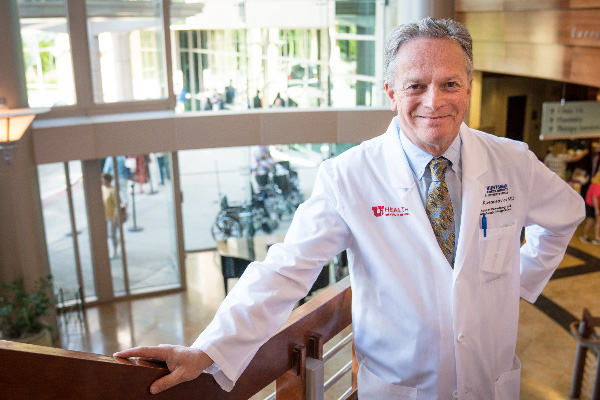
Gary Hecox thrives on outdoor activities and challenging himself. A top-notch medical team cared for him, but his persevering nature, strong support system, and a good mental health therapist helped him stay the course in a fight for his life.
Gary Hecox had hit ruts before, but this one was different. As a longtime ski-race volunteer for Park City Mountain Resort, Gary was hauling a 60-pound pack loaded with timing gear down the mountain when his skis caught. He didn’t fall, but he felt an instant shock of pain in his back.
“Damn, I tweaked it,” thought Gary, a man used to pushing through pain on many of his endurance outings, including 100-mile bike rides and mountaineering treks.
That was a winter day in 2014. What lay ahead of Gary would demand more endurance—physical and mental—than he had ever imagined.
The back pain did not go away; so a few days later, Gary went to see his primary care doctor, Joseph Berman, MD, who—like Gary—suspected a sprain. He prescribed muscle relaxants. Because Gary was there, the doctor also ordered his annual bloodwork.
Gary’s pain increased, however, and two weeks later, an X-ray revealed one collapsed and two fractured vertebrae. This fit, 62-year-old, outdoor recreationist broke his back by hitting a bump in the snow.
About this time, the results of Gary’s annual bloodwork also came back, offering the first signs that something was wrong. The results showed anemia, high calcium, and signs that his kidney function was poor. His wife, Gail, who works in laboratory medicine, knew something was amiss.
Gary Hecox“This is not a battle but a daily physical and mental struggle to keep going with little to no ‘heroics’ on my part. I'm just a passenger on the cancer train, wherever it goes, with little control over anything.”
Gary made an appointment with an orthopedic doctor, but his back began to spasm before he could see the doctor. He ended up in the emergency room. Gail pointed out his test results to the clinicians, but the focus remained solely on Gary’s back. “I knew it was not just his back, yet his diagnosis was pegged as just orthopedic for months,” Gail recalls.
Meanwhile, Berman, who also suspected something else, ran more tests and sent Gary to specialists. Still, no answers. To address Gary’s poor kidney function, he sent him to see nephrologist Terrence Bjordahl, MD, at University of Utah Health.
Bjordahl took a step back and looked at the whole picture. As he started connecting the dots, he did not like what he suspected. “When I heard Gary’s story and then looked at what his lab tests were showing—anemia, high protein in his urine, high calcium in his blood—I knew multiple myeloma was a strong possibility,” Bjordahl says. He would soon discover that Gary’s kidneys were functioning at only 60 percent.

Bjordahl ran a battery of lab tests, then one for multiple myeloma, which involves the detection of proteins and monoclonal antibodies in the blood. This test came back positive. The results of Gary’s annual bloodwork made sense now. The myeloma, a blood cancer, attacks bone and causes hypercalcemia, or high calcium levels in the blood, as well as weakened bones. Myeloma cells also produce high levels of abnormal proteins in the blood. This and the calcium are hard on the kidneys as they try to filter (clean) the blood. Cancerous cells overran Gary’s healthy bone marrow, inhibiting his red blood cell production and causing anemia.
Gary had likely had the disease for many months, and the first cellular abnormalities could have occurred years before. “This disease evolves in steps,” explains Tibor Kovacsovics, MD, the Huntsman Cancer Institute (HCI) blood cancer specialist who oversaw Gary’s care. “You may have this disease even before any symptoms are evident; doctors may just start noticing an increase in proteins in the blood and then eventually start seeing a plasma disorder. Over time this ends up as multiple myeloma,” adds Kovacsovics, who is also a professor of internal medicine at the University of Utah.
A Vital Journey Deep into His Bones
It had been four months since the day on the mountain when Gary’s back broke, and test results showed his health was declining rapidly. A bone marrow biopsy revealed that 70 percent of the cells in his bone marrow were cancerous. Under the watch of Kovacsovics and the HCI care team, Gary began weekly chemotherapy treatments. His brain was in a chemo fog; his body refused food and sleep. Over four months of chemo, his hair fell out and he was forced to walk with a cane. “He didn’t look like the Gary I had been married to for over 40 years,” Gail says.
Good news arrived in August. A bone marrow biopsy revealed that only 30 percent of the cancer remained. However, Gary’s cancer cell count needed to drop to 20 percent for him to qualify for a bone marrow transplant. This last push would be the hardest and the most dangerous; Gary would be brought to the very edge of death.
Gary lay in a hospital bed at HCI while an IV pumped a concoction of five chemo drugs into his body over three days until tests revealed his cancer cell count had dropped to 20 percent. He then was given medication to stimulate stem-cell growth in his bone marrow (stem cells are immature cells that produce all of the blood cells in the body). About 10 million stem cells were extracted and stored.

Two weeks later, Gary was ready for his stem-cell transplant. Preparation required one final dose of chemo to destroy the rest of the blood cells, both cancerous and normal, in Gary’s bone marrow. The next day, an IV began delivering half of the harvested stem cells back into Gary’s body, sending them on a vital journey to his bone marrow to begin growing.
“We save the other half for patients if they relapse, so the remaining stem cells can be used for a second transplant,” Kovacsovics says.
“I could actually watch the stem cells going into my body—rather cool,” Gary wrote on his Facebook page. He added, “The next couple of weeks will not be a lot of fun, but then it will get better as my bone marrow learns to live again.”
Gary and his family anxiously waited to see if the stem cells would engraft. This would mean that Gary’s stem cells had started growing and producing healthy blood cells. Lab tests were used to monitor Gary’s blood counts, and a clinician jotted down the counts on a white board, under the watchful, hopeful eyes of his family and care team. “There's a lot riding on those little guys knowing what to do…It's scary but all we can do is wait and trust the science,” wrote his daughter, Bridget, in a Facebook post.
Archana Mishra Agarwal, MD“Diagnosing and treating blood cancer involves rapid advancements; research is constantly revealing new findings. This constant stream of new discoveries really keeps me on my toes and allows us to more accurately diagnose and monitor patients. The learning is constant, which is what I love.”
Medical Director
Gary no longer had an immune system; he was not allowed to leave the transplant unit, and his family carefully “scrubbed down” to prevent the spread of germs when visiting him.
The months ahead for Gary would require more grit and perseverance than he had ever needed before. He was too weak to pick up a glass of water, chronically nauseous, and unable to focus. The emotional toll of sickness and the possibility of death pressed on him. Weight slipped off him—a total of 60 pounds.
“This is not a battle but a daily physical and mental struggle to keep going with little to no ‘heroics’ on my part,” wrote Gary on Facebook. “I'm just a passenger on the cancer train, wherever it goes, with little control over anything. Just keep moving.”
Out of the hospital but still recovering, Gary leaned hard on the HCI’s wellness center, the Linda B. and Robert B. Wiggins Wellness and Integrative Health Center, where he went twice a week to build physical strength and improve his morale. “It’s nice to go to a place where everybody is in the same boat and you don’t have to explain everything.”
A Life Governed by Lab Test Results
Six months later, and hundreds of lab tests since that broken back, a bone marrow biopsy revealed that Gary was cancer free. It was an early spring day in Park City, and to celebrate, he and Gail took a bike ride. It was his first ride since being diagnosed. “It was only 3 miles but it was a big milestone for me,” Gary recalls. “He did better than me,“ Gail quips.

Gary is now four years into remission. Every three months, he’s screened for multiple myeloma; and he receives a bone marrow biopsy annually. “It is all about the lab test—our lives are dependent on those results,” Gail says. “All those people—from beginning to end—who are carefully working to get the results back to us are heroes. They may not know it, but they are impacting and touching our lives.”
“My life is now governed by those results—whatever they are, good or bad—we are never more than a few steps from the next lab test,” Gary adds.
Numerous labs at ARUP are involved in helping physicians figure out if their patients have a blood cancer, and if they do, which kind. Tests run at ARUP also help clinicians monitor whether treatment is effective. “Over a hundred different types of blood cancers are diagnosed here—all subtypes of leukemia, lymphoma, and myeloma,” says Rodney Miles, MD, PhD, section chief of Hematopathology. “Some are very common and we see them every week; others are rare, and we may only see them once a year or every few years.”
Multiple myeloma is among the hematologic system diseases referred to as plasma cell dyscrasias. Testing for plasma cell dyscrasias starts with determining the presence and type of monoclonal proteins, or “M proteins,” which are increased in the blood of people with multiple myeloma. Quantification of light chains (proteins produced by plasma cells) in the blood, referred to as serum free light chains, helps to diagnose multiple myeloma and determine prognosis.
Monitoring multiple myeloma relies on copious amounts of testing —including blood cell counts, kidney function testing, and very careful oversight of the serum proteins.
Testing for multiple myeloma at ARUP involves five labs: Hematologic Flow Cytometry, Cytogenetics, Special Hematology, Protein Immunology, and the University Division Clinical Labs. Hematopathologists in the Clinical Pathology Division at the University of Utah (U of U), review all bone marrow biopsy cases. All of these labs are involved in the testing of all blood cancers, with the exception of Protein Immunology.
ARUP, located near the U of U School of Medicine, is one of two well-established, academic-medical reference laboratories in the country. It processes about 55,000 tests daily.

Before results leave ARUP and head back to the physician, a medical director who specializes in blood cancers reviews the results. “We take a holistic look, taking into account all the different results from all the different labs, to arrive at a diagnosis,” explains Miles, who is also an associate professor of pathology at the U of U.
“It is not always clear-cut,” admits Miles, who collaborates with his ARUP colleagues on the more difficult-to-diagnose cases. For the especially unusual findings, they dive into the published literature to find answers and to continue to build their own knowledge base. “Every week we are seeing something new.” The centralization of ARUP’s 65-plus labs make it easy for medical directors to collaborate.
Experts have identified more than 150 types of blood cancers, plus many subtypes. “For example, Leukemia is one thing to the lay community and it is a hundred things to us,” Miles says. “We try to separate out exactly what type, because it will guide treatment and inform the prognosis.”
“For multiple myeloma, some genetic subtypes are more aggressive than others,” Kovacsovics explains. “Some are at stages that just need to be observed, and then there are other stages in which you must begin treatment.”
It's All Good in the Sun, Rain, and Snow
As of last spring, Gary learned that he has a 20 to 30 percent chance of living another eight to 10 years. “That’s right in line with the statistics,” says Gary, whose mind feeds on facts. It has served him well in his profession; he is a geologist with a PhD.
“Gary is going strong; he is really in great physical shape and has an amazing drive,” says Kovacsovics, who values the relationships he is able to have with his patients. “In my area, you’re in it for the long haul with your patients, so you really get to know them well.”
Since regaining his strength, Gary has wasted no time adding miles to his life’s odometer, with plenty of ski days and trips to the Cayman Islands and Iceland to scuba dive. This year he pedaled more than 2,200 miles and fit in 150,000 feet of climbing. Still a ski-race volunteer, Gary says, “I love working with the kids and being around their enthusiasm.”
On his Facebook page, where he has chronicled his multiple myeloma journey, one post reads: “Yesterday at Park City training I was asked what is most important in my life. My answer? Living.” Gary then signs off, as he has for every one of his postings from diagnosis through remission: “It's all good in the sun, rain, and snow.”
Peta Owens-Liston, Sr. Science Communications Writer
Related blog
"It Must Be In the Cells: Three Generations of Histologists"
















